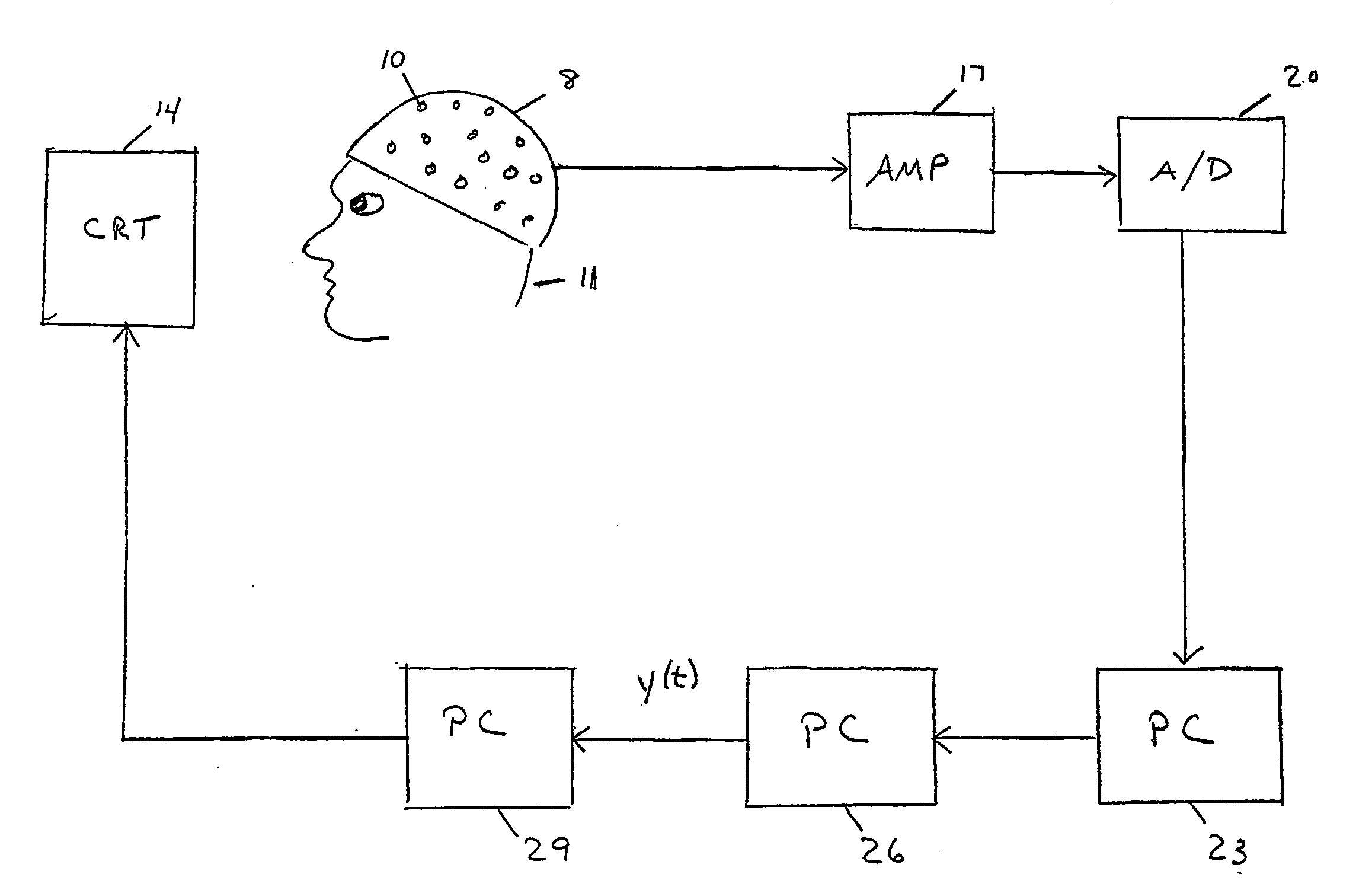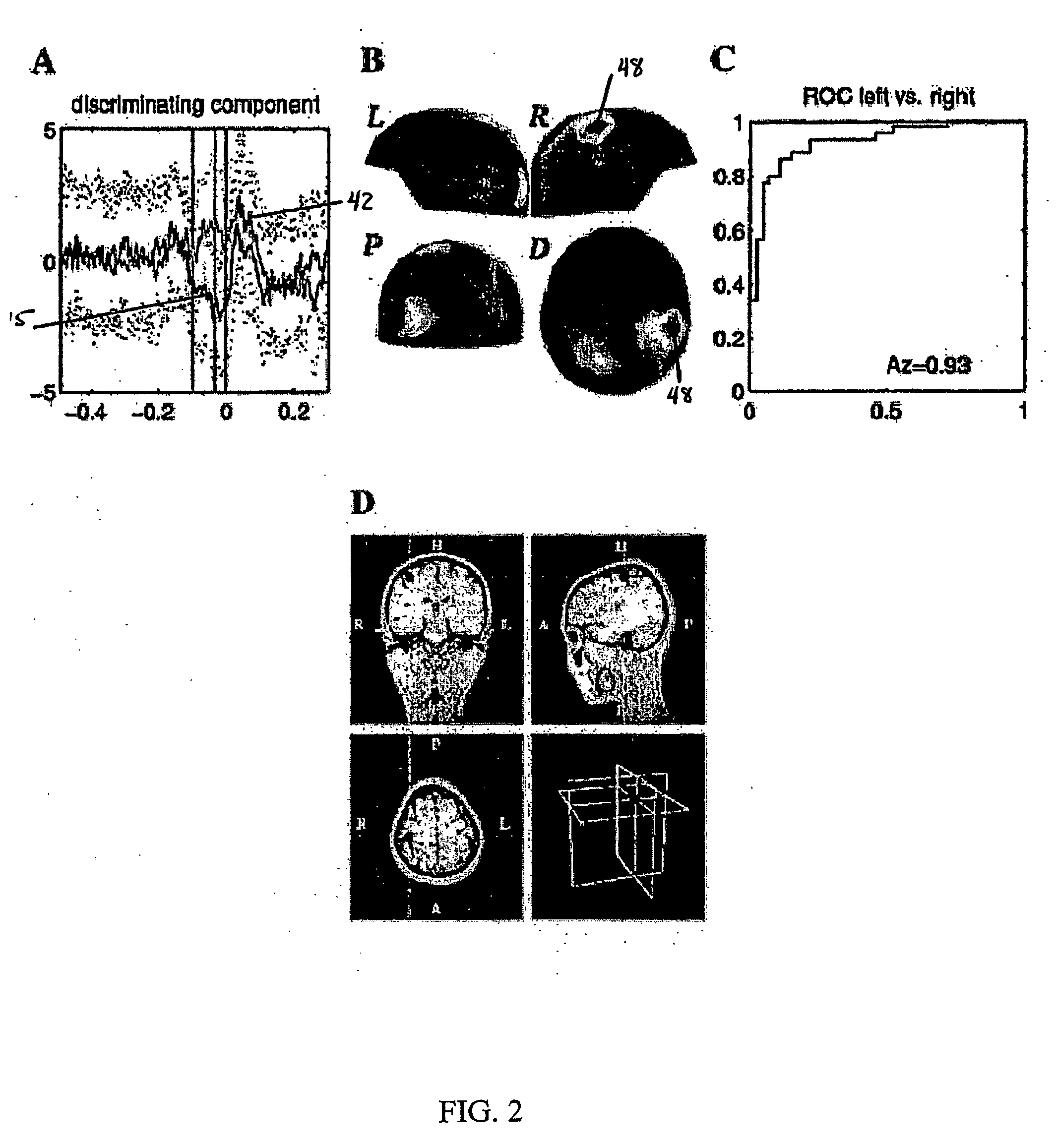Single trial detection in encephalography
a single trial and detection technology, applied in the field of single trial detection in encephalography, can solve the problems of difficult adaptation of machine learners, difficult trial averaging, and blind source separation that does not exploit the timing information of external events that are often available, and achieves good single trial discrimination, short period of time, and maximum performance of a bci
- Summary
- Abstract
- Description
- Claims
- Application Information
AI Technical Summary
Benefits of technology
Problems solved by technology
Method used
Image
Examples
example i
[0024]Predicting explicit (overt) motor response using MEG: Four subjects performed a visual-motor integration task. A “trump” experiment was defined whereby subjects were simultaneously presented with two visual stimuli on a CRT, one of which is the target and “trumps” (beats-out) the other. Subjects were instructed to push a left hand or right hand button, depending on which side the target (trump stimulus) was present. The subject was to discover the target by trial and error using auditory feedback. Each trial began with visual stimulus onset, followed by button push, followed by auditory feedback, indicating if the subject responded correctly. The interval between the motor-response and the next stimulus presentation was 3.0±0.5 sec. Each subject performed 90 trials, which took approximately 10 minutes. MEG data was recorded using 122 sensor at a sampling rate of 300 Hz and high-pass filtered to remove DC drifts. Dipole fits were done using the “xfit” tools available from Neuro...
example ii
[0025]Classifying imagined imagined (covert) motor activity using EEG: Nine subjects performed a visual stimulus driven finger (L / R) tapping task. Subjects were asked to synchronize an explicit or imagined tap by the left, right, or both index fingers to the presentation of a brief temporally predictable signal. Subjects were trained until their explicit taps occurred consistently within 100 ms of the synchronization signal. Subjects were presented visual stimuli indicating with which index finger to tap and if it should be an explicit or imagined tap. 1.25 seconds after the last instruction symbol a fixation point was replaced for 50 ms by the letter “X.” This letter served as a signal to which the instructed tap (whether overt or imagined) was to be synchronized. Each trial lasted for 6 s. After training, each subject received 10 blocks of trials. Each 72-trial block consisted of nine replications of the eight trial types (Explicit vs. Imagined x Left vs. Right vs. Both vs. No Tap...
example iii
[0026]Detection of decision errors from EEG: Seven subjects performed a visual target detection amongst distractors task. On each trial, subjects were presented with a stimulus for 100 ms. There were four possible stimuli, each consisting of a row of five arrows. Subjects were told to respond by pressing a key on the side indicated by the center arrow. They were to ignore the four flanking arrows. On half of the trials, the flanking arrows pointed in the same direction as the target (e.g. <<). Subjects were slower and made many more errors in the latter case. Following their response, there was an inter-trial interval of 1.5 seconds, after which a new stimulus was presented. Subjects performed 12 blocks of 68 trials each. The 100 ms interval prior to the response was used as the baseline period (separately for each trial and electrode). The sampling rate was 250 Hz. Following the baseline period, trials were manually edited to remove those with blinks, large eye movements, instrumen...
PUM
 Login to View More
Login to View More Abstract
Description
Claims
Application Information
 Login to View More
Login to View More - R&D
- Intellectual Property
- Life Sciences
- Materials
- Tech Scout
- Unparalleled Data Quality
- Higher Quality Content
- 60% Fewer Hallucinations
Browse by: Latest US Patents, China's latest patents, Technical Efficacy Thesaurus, Application Domain, Technology Topic, Popular Technical Reports.
© 2025 PatSnap. All rights reserved.Legal|Privacy policy|Modern Slavery Act Transparency Statement|Sitemap|About US| Contact US: help@patsnap.com



